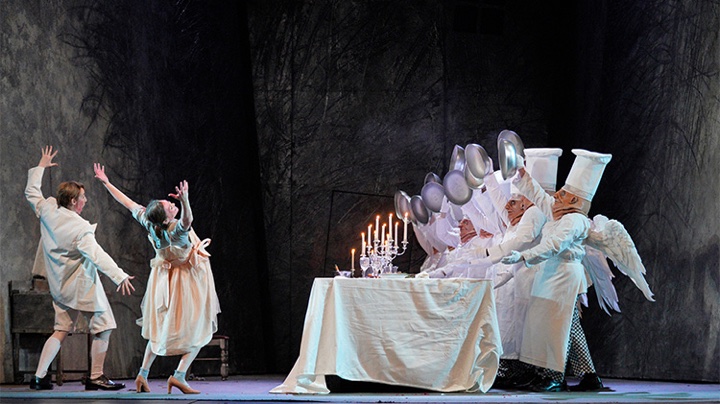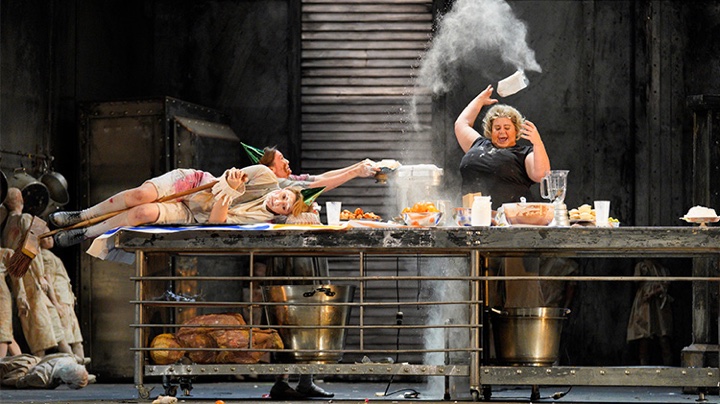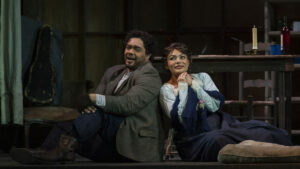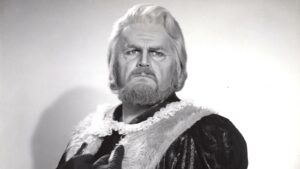
At the same time, their lighthearted approach to the problem allows the fairy tale narration to spin forward. In all the scenes, the front curtain is a picture of a giant plate, first empty, then later bloody and then broken.
In Jones’ production, both Hansel and Gretel use distinctive movement patterns to establish characterization. This movement helps the adult singers personalize their childlike characters, though occasionally it seems “over the top”. When their mother returns, in her frustration at their behavior, she sends them to pick strawberries, beginning their adventures into and out of the woods.
John Macfarlane’s effective sets and costumes are quite visually effective, especially in the dream sequence in Act 2, when Hansel and Gretel are attended by 14 angels dressed as chefs with a Mater Dei with the head of a fish! There are also human trees that are appropriately menacing as night falls in the woods. Jennifer Tipton’s lighting is appropriately gloomy for the night scenes, but perhaps a bit dark in Act Two when it’s very hard to see the upstage trees in their subtle movement.
The singing is excellent across the board. Mezzo Samantha Hankey, making her Lyric debut, sings a charming and boyish Hansel, at best when he’s being protective of his sister. Heidi Stober is a delight as Gretel and, while her voice took a while to warm up, her soft-toned soprano shone through in both her moments of repose and those of anger or fear.
Both ladies admirably threw themselves full tilt into the stylized movement of their characters—I was sometimes surprised that Gretel wasn’t too out of breath to sing!
It is always dangerous to cast singers that look like they haven’t missed any meals in roles that sing about how starving and desperate for food they are. But happily, Alexandra LoBianco and Alfred Walker as the Mother and Father have big, boisterous voices and the acting chops to make the roles outstanding. Both have excellent comic timing, Ms. LoBianco particularly affecting in her moments of overwrought emotion.
Soprano Denis Velez sang with lovely, limpid tone in her dual roles of the Sandman and the Dew Fairy, In Act Three, the children of Uniting Voices Chicago (formerly Chicago Children’s Choir) came to life from being cursed by the Witch, and sang a finale of ravishing beauty and perfect unison.
Jill Grove’s Witch, here dressed rather like a suburban hausfrau, was a pleasure to see and hear. She was an unusually subdued witch in her outward behavior, which helped make her seduction of the children more believable, then turned almost frightening in casting her spells. She also used a wildly raucous cackle to great effect. Her “industrial strength” oven was a perfect fit when she was thrust inside by Hansel and Gretel, and the audience applauded her demise.
Sir Andrew Davis was masterful in the pit, finding all the nuances and subtle shifts in Humperdinck’s lavish, almost Wagnerian score, and the Lyric Opera Orchestra played perfectly.
I was particularly taken by the overture (which has to be one of the longest in all opera) where all the music’s various themes came together in stirring fashion. The entr’acts for both Acts Two and Three were also splendid.
httpvh://youtu.be/Sfp9qqlOEaw
There were a few unneeded directorial efforts, for instance in Act One when the Mother appears to down a whole bottle of pills (tranquilizers?) but then showed no effect of them in the rest of the act. Moments like these simply distract the audience’s attention—we spent a while wondering about the pills instead of following the thrust of the scene.
Also, why does the Father try to come in the window instead of the door? Again, it may establish his drunkenness, but it’s totally distracting.
It was a very satisfying musical afternoon. Still, this production is played at such a general level of hysteria, especially in Acts One and Three, that I suspect it was a way to try to keep the children in the audience’s attention. I think we adults would prefer the calmer, sleepy tone of Act Two.
Photo: Cory Weaver







Comments